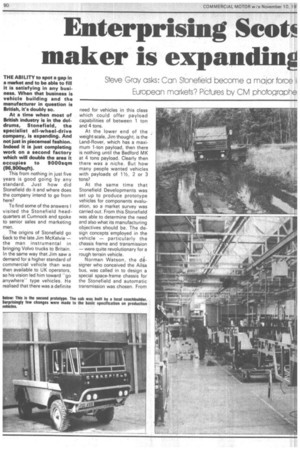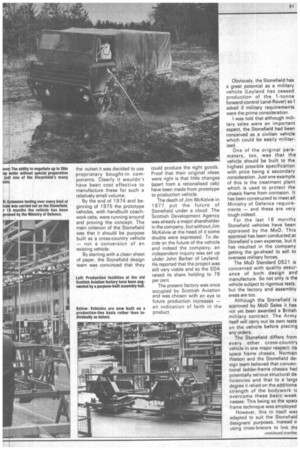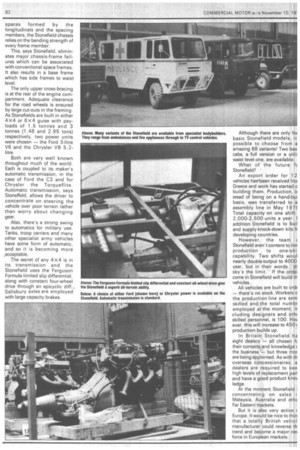• Enterprising Seob maker is expanding
Page 92

Page 93

Page 94

If you've noticed an error in this article please click here to report it so we can fix it.
Steve Gray asks: Can Stonefield become a major force i European markets? Pictures by CM photoaraphe
THE ABILITY to spot a gap in a market and to be able to fill it is satisfying in any business. When that business is vehicle building and the manufacturer in question is British, its doubly so.
At a time when most of British industry is in the dol drums, Stonefield, the specialist all-wheel-drive company, is expanding. And not just in piecemeal fashion.
Indeed it is just completing work on a second factory which will double the area it occupies to 9000sqm (96,900sqft).
This from nothing in just five years is good going by any standard. Just how did Stonefield do it and where does the company intend to go from here?
To find some of the answers I visited the Stonefield headquarters at Cumnock and spoke to senior sales and marketing men.
The origins of Stonefield go back to the late Jim McKelvie — the man instrumental in bringing Volvo trucks to Britain. In the same way that Jim saw a demand for a higher standard of commercial vehicle than was then available to UK operators, so his vision led him toward "go anywhere" type vehicles. He realised that there was a definite need for vehicles in this class which could offer payload capabilities of between 1 ton and 4 tons.
At the lower end of the weight scale, Jim thought, is the Land-Rover, which has a maximum 1-ton payload, then there is nothing until the Bedford MK at 4 tons payload. Clearly then there was a niche. But how many people wanted vehicles with payloads of 11/2, 2 or 3 tons?
At the same time that Stonefield Developments was set up to produce prototype vehicles for components evaluation, so a market survey was carried out. From this Stonefield was able to determine the need and also what its manufacturing objectives should be. The design concepts employed in the vehicle — particularly the chassis frame and transmission — were quite revolutionary for a rough terrain vehicle.
Norman Watson, the designer who conceived the Ailsa bus, was called in to design a special space-frame chassis for the Stonefield and automatic transmission was chosen. From the outset it was decided to use proprietary bought-in components. Clearly it wouldn't have been cost effective to manufacture these for such a relatively small volume.
By the end of 1974 and beginning of 1975 the prototype vehicles, with handbuilt coachwork cabs, were running around and proving the concept. The main criterion of the Stonefield was that it should be purpose built as a cross-country vehicle — not a conversion of an existing vehicle.
By starting with a clean sheet of paper, the Stonefield design team was convinced that they could produce the right goods. Proof that their original ideas were right is that little changes (apart from a rationalised cab) have been made from prototype to production vehicle.
The death of Jim McKelvie in 1977 put the future of Stonefield under a cloud. The Scottish Development Agency was already a major shareholder in the company, but without Jim McKelvie at the head of it some doubts were expressed. To decide on the future of the vehicle and indeed the company, an independent inquiry was set up under John Barber of Leyland. He reported that the project was still very viable and so the SDA raised its share holding to 76 per cent.
The present factory was once occupied by Scottish Aviation and was chosen with an eye to future production increases — an indication of faith in the product. Obviously, the Stonefield has a great potential as a military vehicle (Leyland has ceased production of the 1-tonne forward-control Land-Rover) so I asked if military requirements were the prime consideration.
I was told that although military sales were an important aspect, the Stonefield had been conceived as a civilian vehicle which could be easily militarised.
One of the original parameters, too, was that the vehicle should be built to the highest possible specification with price being a secondary consideration. Just one example of this is the treatment plant which is used to protect the chassis frame from corrosion. It has been constructed to meet all Ministry of Defence requirements — and these are very tough indeed.
For the last 18 months Stonefield vehicles have been appraised by the MoD. This appraisal has been conducted at Stonefield's own expense, but it has resulted in the company getting the go-ahead to sell to overseas military forces.
The MoD Standard 0521 is concerned with quality assur ance of both design and manufacture. So not only is the vehicle subject to rigorous tests, but the factory and assembly areas are too.
Although the Stonefield is approved by MoD Sales it has not yet been awarded a British military contract. The Army itself will carry out its own tests on the vehicle before placing any orders.
The Stonefield differs from every other cross-country vehicle in one major respect: its space frame chassis. Norman Watson and the Stonefield de sign team believed that conventional ladder-frame chassis had potentially serious structural deficiencies and that to a largE degree it relied on the additiona strength of the bodywork tc overcome these basic weak nesses. This being so the spacc frame technique was employed However, this in itself was adapted to suit the Stonefield designers' purposes. Instead using cross-bracers to link thE spaces formed by the longitudinals and the spacing members, the Stonefield chassis relies on the bending strength of every frame member.
This, says Stonefield, eliminates major chassis-frame failures which can be associated with conventional space frames. It also results in a base frame which has side frames to waist level.
The only upper cross-bracing is at the rear of the engine compartment. Adequate clearance for the road wheels is ensured by large cut-outs in the framing. As Stonefields are built in either 4x4 or 6x4 guise with payloads of 1.5 tonnes and 3 tonnes (1.48 and 2.95 tons) respectively, two power units were chosen — the Ford 3-litre V6 and the Chrysler V8 5.2litre.
Both are very well known throughout much of the world. Each is coupled to its maker's automatic transmission, in the case of Ford the C3 and for Chrysler the Torqueflite. Automatic transmission, says Stonefleld, allows the driver to concentrate on steering the vehicle over poor terrain rather than worry about changing gear.
Also, there's a strong swing to automatics for military use. Tanks, troop carriers and many other specialist army vehicles have some form of automatic, and so it is becoming more ,acceptable.
The secret of any 4x4 is in its transmission and the Stonefield uses the Ferguson Formula limited slip differential, along with constant four-wheel drive through an epicyclic Salisbury axles are employed with large capacity brakes. Although there are only foi basic Stonefield models, it possible to choose from a amazing 68 variants! Two bas cabs, a •full version or a utili waist level one, are available.
What of the future fc Stonefield?
An export order for 12 vehicles hastheen received froi Greece and work has started c building them. Production, ir stead of being on a hand-bui basis, was transferred to a assembly line in May 197£ Total capacity on one shift 2,000-2,500 units a year. I addition Stonefield is to buil and supply knock-down kits ft developing countries.
However, the team Stonefield aren't content to lirn production to one-shi capability. Two shifts woul nearly double output to 4000 year, but in their words '"th sky's the limit.'" If the ordel come in Stonefield will build tF vehicles.
All vehicles are built to ordi — there's no stock. Workers c the production line are sem skilled and the total numb employed at the moment, ir eluding designers and othi skilled personnel, is 100. Ho% ever, this will increase to 450 production builds up.
In Britain Stonefield ha eight dealers — all chosen ft their contacts and knowledge the business — but three mot are being appointed. As with th overseas concessionaires, a dealers are required to kee high levels of replacement pani and have a good product kno+, ledge.
At the moment Stonefield concentrating on sales i Malaysia, Australia and othf Par Eastern markets.
But it is also very active i Europe. It would be nice to thin that a totally British vehicl manufacturer could reverse th trend and become a major neN force in European markets.












































































































































































































































